INTRODUCTION
In my previous article, I covered the origin and the development of the Su-27 in detail. In this article I will track the evolution of the Su-27 and its combat capabilities and we will see how it compared with its American rival, the F-15. The previous article ended with the acceptance of the Su-27 into the Soviet Air Force. It officially was still a secret fighter and now, the Soviets were ready to unveil it to the world. The details for the story and photos are sourced from the ‘Wings of Russia’ documentary which I recommend Su-27 lovers to watch. Here I have interpreted and given an analytical account of the story as well as additional information from my research. Do read the first part for a better understanding of this article.
EVOLUTION
In 1986, when the Su-27 was still an official secret, it was decided to make a special variant of it which was modified to break the word records set by the F-15 special variant ‘Streak Eagle’ in 1975. This aircraft, for the purpose of secrecy was designated as P-42 as the Soviets still weren’t ready to unveil it to the public. The P-42 was a heavily stripped Su-27 and had all its combat systems and electronics removed in order to reduce its weight to minimum. Its paint was removed as well in order to make it more aerodynamic. The other extremely important factor is the thrust to weight ratio which is directly affected by the weight of the aircraft. The Su-27 had a weight of 23 tons and a thrust of 25 tons, which meant that the thrust to weight ratio exceeded 1. This ensures very good performance.

However, the P-42 was so heavily stripped to make it light that its weight was reduced to almost 12 tons from the initial 23 tons! This meant that the thrust to weight ratio was 2 (because 25/12 is approx =2) which allowed it to attain incredible rates of acceleration. This was demonstrated when the P-42 exceeded the speed of sound in vertical flight! In the next 2 years, the P-42 set more than 30 world records. Test pilot Victor Pugachev broke the F-15 climb record by 2 seconds and Test pilot Nikolai broke the F-15 climb record by 7 seconds by climbing 15 km in 1 minute 16 seconds! This made the Su-27 the winner in the performance parameters round. But it still had a long way to go and was yet to be exposed to the world.


In 1987 the NATO got its first good look at the Su-27 during its operational patrols. The photos taken at that time were the first clear photos possessed by the western intelligence. The first image was taken in 1978 from a spy satellite. At last in 1989, the Soviets decided to display the Su-27 at the Paris air show and unveil its existence to the world formally. It made a spectacular impact by flying nonstop from Zhukovsky, near Moscow to Paris without external fuel tanks and air tanker support. This was done to show to the west that the Su-27 could easily cross over half of Europe and had more range than any other fighter they had. It then vowed the audience and aviation experts with its incredible maneuverability.
It was here that Victor Pugachev performed the famous Pugachev Cobra manoeuver which remains associated like a trademark with the Flanker till date. The Cobra involves the Su-27 going into supercritical angles of attack (>90 degrees) and sharply reducing its speed by about 250 km/hr, to allow the trailing fighter to fly past so that the Su-27 can get on its tail. The illustration below shows how the manoeuver in performed. These excellent characteristics led to the Russian Knights air display team using the Su-27 which is popular all over the world.



Illustration of Su-27 performing cobra manoeuver
It was in this particular air show that Chinese and Indian officials paid attention to the Su-27 and the Soviet Union was going to get large export orders from these 2 nations in the coming years. The Chinese procured the Su-27 and made their own copies. They later on procured the multirole Su-30 as well. India however took a different approach. They wanted a Su-30 which was fitted with their choice of avionics sourced from western nations. This resulted in the Su-30Mki which remained the best variant of Su-30 in service until Russia started producing the S-30SM. It is interesting to note that these Su-30s are twin seaters. India became the largest Su-30 customer when their order for the Su-30Mki touched 272 aircraft.
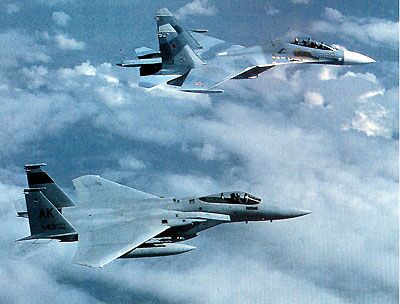
In 1992, a long awaited dream came true for both sides when after negotiations, the Su-27s made a friendly visit to the USAF base in Virginia for mock combat with their nemesis F-15s. It was decided that there would be 2 rounds of dogfights in which the Su-27 would be the tail for one round and vice versa for the other round. First, the Su-27 tailed the F-15 in a mock dogfight, but the Eagle failed to break the tail and disengage the Flanker. In the second round, the F-15 tailed the Su-27. The flanker pilot managed to rapidly reduce speed and did a one and half turn which made the F-15 to shoot past and put the flanker on the tail of the eagle. This meant that the Su-27 clearly won both the mock dogfighting rounds and showed its worth. The America general flew in a 2 seat Su-27 and later on indicated that its maneuverability was better than that of the F-15. It was a sweet victory for the Su-27 of the now Russian Air Force.
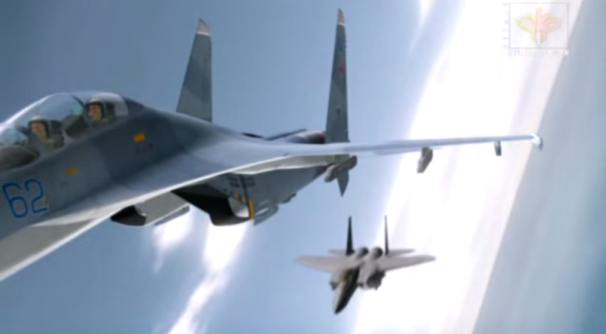

Let us now examine the exact combat capabilities and features of the Su-27. The initial Su-27 production models had a completely analog cockpit with a tiny display for the radar. The pilot used a helmet mounted sight to aim his weapons. The radar was a mechanically scanning radar which could detect fighter sized targets at 100+ km. It also featured an optical detection system which consisted of an infrared Search & Track system and a laser rangefinder. This allowed to the Su-27 to detect targets at around 50 km passively, without using its radar and exposing itself. This feature would be very crucial in close combat scenarios. The radar, optical sensors and the helmet mounted display were completely integrated and used in conjunction to ensure optimal combat performance. Systems like helmet mounted display and the IRST were missing from its rival, the F-15. It is also interesting to note that the twin seater Su-27UB had the same capabilities of the single seater with no reduction in capabilities whatsoever.

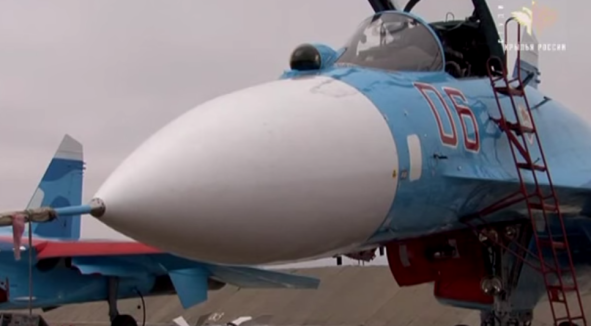
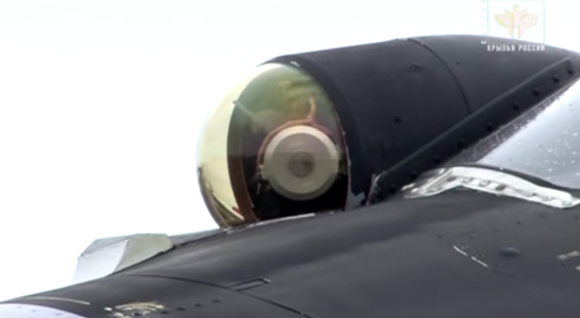
The basic Su-27 was an air superiority fighter and lacked air to ground capabilities. However the following batch was upgraded to Su-27M standard and was fitted with a new radar which enables it to detect air and surface targets and carry air to air and air to ground weapons. This made it a true multirole fighter but it didn’t enter service due to economic troubles and instability in the early 1990s. But there was another variant of the Su-27 which was lucky. The Su-27K was chosen to be the main fighter of the Soviet Navy and was redesigned to operate from their fleet of new carriers which were being built. The main role of the Su-27K ( renamed as Su-33) was to provide protection to a Soviet Naval battle group from air attacks launched by the US Navy’s extremely powerful carriers. Only small numbers of the Su-33 were built before their production was stopped and with the collapse of the Soviet Union, the carrier fleet dream also ended. Only one carrier was in service with around a dozen Su-33 fighters based on it. This was how the Soviet dream of a powerful carrier based fleet of fighters was cut short.

The missile load of the Su-27 is highly enviable. It has 10 hardpoints which can accommodate 10 air to air missiles in air superiority mode which was increased to 12 on later models. This is twice the usual load of lightweight fighter and definitely more the the F-15 as the Su-27 never had to waste hardpoints for carrying external fuel tanks due to the massive range provided by the internal fuel tanks itself. This meant that the Su-27 could stay in the fight, long after its rivals had exhausted their missiles. The missiles carried include the R-73, R-77 and R-27 Air to Air missiles. Nearly every type of bomb and missile in the Soviet inventory could be carried by the Su-27 although its abilities as a multi role fighter were limited. The need for a tactical bomber with the performance of the Su-27 led to the development of the Su-34 fighter-bomber which is currently unparalleled in its capabilities.

The Su-27 didn’t stop at the Su-30 evolution. The Sukhoi design bureau further improved upon the Su-27 and developed the Su-35/37. These aircraft featured large multifunction LCD displays in their cockpit and the revolutionary new 3D thrust vectoring control (TVC) nozzles for their engines which gave them what we call as supermanoeuverability which enables it to out turn its rivals in a dogfight. These aircraft are unequaled in range, payload and maneuverability by any other fighter. The thrust vectoring nozzles was also adopted on some of the Su-30 series. The Su-37 was basically a technology demonstrator and the Su-35 design was adopted for serial production. The Su-35 is essentially a Su-37 without the canards in front of the main wings. The Su-35S is the latest variant which is a single seat multirole fighter. It was put into full scale production and the Russian Air Force has ordered around 100 aircraft.

The major difference in the Su-30/35 when compared to the Su-27 is the presence of a Passive Electronically Scanning Radar (PESA) and 12 missile carrying hardpoints which can be increased to 14 in an Air to Air load where 4 R-77 (RVV-AE) missiles can be fitted under the fuselage, 2 R-77 under engine air intakes, 4 R-77 and 4 R-73 under wings. The even shocking fact is that the number of hardpoints can be increased to 16! This is done using multiple ejector racks to carry lightweight AAMs or Rocket pods. Can you name any other aircraft in the world has a similar weapon load and yet retains a 1000+ km combat radius? These aircraft are fully multirole are now scheduled to get X-band AESA radars. The Su-35S has a wing mounted L-band radar which is said to be capable of detecting stealth aircraft and long ranges. The Indian Su-30Mki is rumoured to get this capability after its upgrade as well. They also feature an advanced optical detection system and IRST to passively detect aircraft. These features and abilities, theoretically put the upgraded Su-30Mki, Su-30SM and the Su-35S beyond the capabilities of the F-15 and only the F-22 can be considered as a rival for these deadly Russian fighters.
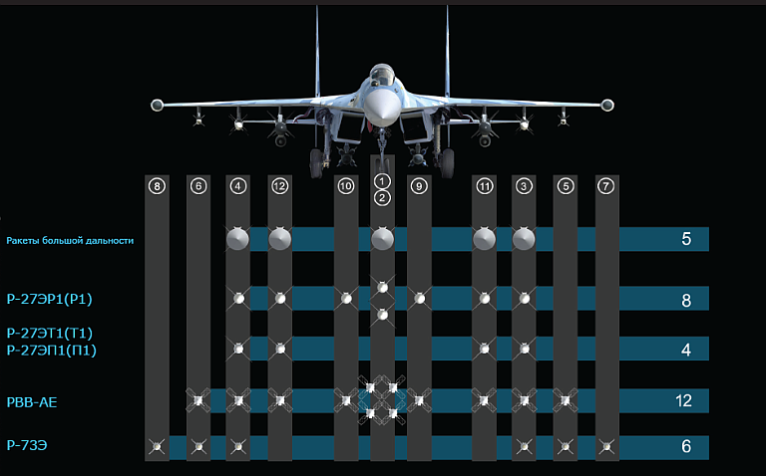

CONCLUSION
I have highlighted the incidents and performance parameters of the aircraft and it should not be assumed the Su-27 will defeat the F-15 in combat. It depends entirely on the skill of the pilots on both sides, the support assets and the number of aircraft available. The F-15 has proven to be extremely successful in all the wars it has participated in till now and none have been lost in air to air combat. Whereas the Su-27 is largely unproven in combat. Until a Flanker and Eagle of major air forces face off in actual combat, we won’t know what will happen if these legends clash.
Note: CG images © Wings of Russia, Article © Defencyclopedia
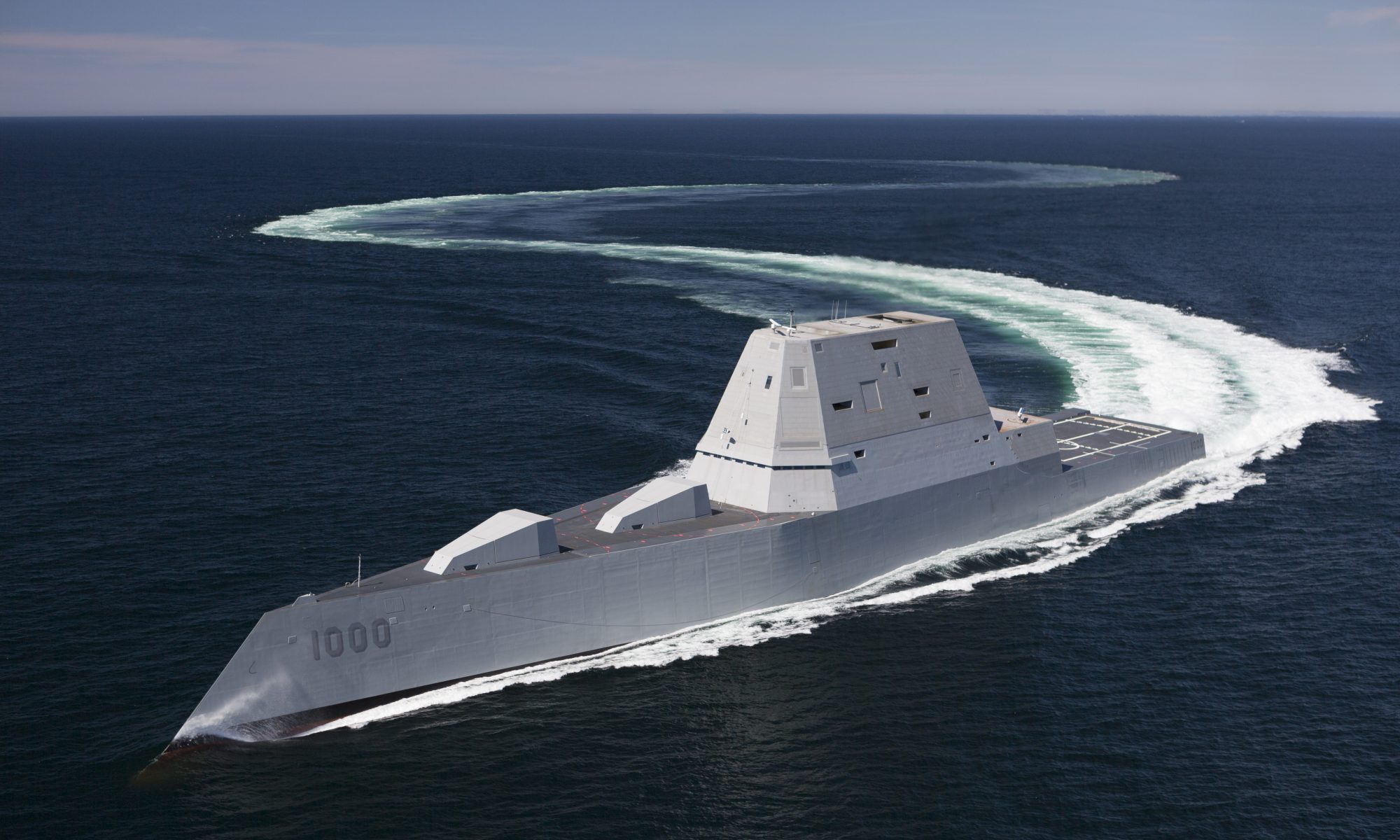


very informative & well written article.
LikeLiked by 1 person
Thank you
LikeLike
The f15 has been shot down several times……Israel has lost alot and we’ve lost a few. …..don’t believe the f15 has never been shot down…..because it’s had its tail kicked quiet a few times
LikeLike
Oh my goodness, this is my new favorite site. Where has this site been my whole life.
Thank you for the professional and extremely entertaining thought provoking content.
This is wonderful.
LikeLike
awesome job here, loved it!!!
LikeLike
Thank you
LikeLike
Could you please tell what is the use of tail in Sukhois?
Most of American-built jets do not have one
LikeLike
Every American fighter jet has a tail.
The tail is used for stabilization purposes and for direction changing.
LikeLike
If you mean the conical part beetwen two engines, that is a fairing to protect a second radar. Is a warning radar to detect enemy missiles and aircrafts.
LikeLike
Very good article, I will say I love the Eagle, but the Flanker is better than it at WVR (Within Visual Range), but has there been a mock trial of theese two planes doing BVR (Beyond Visual Range), the MiG-29 could beat an F-15 at WVR, but has never scored a kill on the Eagle, the Eagle on the other hand has killed 104 MiGs in BVR, so there is no absolute proof the SU-27 could beat an Eagle in BVR, it’s like the Raptor and the Typhoon, the Raptor in mock trial combats has always lost to the typhoon, but those were WVR, never been tested in BVR, plus the raptor still can have an advantage over the typhoon, the Typhoon loses it’s peak performance above 39,000 feet, the air frame starts shaking, and the plane is less maneuverable, The Raptor at above 39,000 feet still preforms amazingly, it actually is more maneuverable than the Typhoon, and probably could beat it at WVR above 39k feet
LikeLiked by 1 person
Oh, and btw I mean the Raptor is more maneuverable than the Typhoon above 39k feet, below it is less.
LikeLike
Thanks Austin. The Flanker is definitely superior at WVR and has defeated the Eagle in all mock engagements. However they have never been pitted against each other in BVR combat. It would be interesting as the American fighters have superior BVR radar and Russian fighters have superior BVR AAMs.
LikeLike
I would like to point out one thing here.
Many people agree that this kill-ratio is more of a propaganda rather than actual truth.
You can see the same by yourself by checking the Russian side of the story, which will present entirely different ratios/stories for the same conflict.
Only exception (probably) can be 6-day war in 1967, but then again it is widely believed that Israeli pilots were far better trained.
Needless to say, we might never know the truth.
LikeLike
Your statement on all of the F-15’s 104 kills being BVR is incorrect. Most of these kills (75%) were within WVR. There are many sources to research this in pilot interviews in military aviation books. The Osprey book company is a good place to start. There are no released numbers in the Typhoon vs Raptor trials, but a nahdful of candid interviews claiming numerous kills, by both sides. And until just recently (I believe 2013) The USAF has had a little discussed unit in Nevada full of Russian built fighters that they train USAF pilots against so they know how to manuever against them when they confront them in air combat. The German Air Force has also assisted the USAF in training against their MiG-29s. USAF and USN pilots frequently defeat the German pilots, and the Germans are very, very good pilots.
LikeLike
That isn’t even true. We know that the Typhoon has shot down Raptors because Euros throw stickers on the sides of their Typhoons. That doesn’t mean that they shot down more Raptors than The number of Typhoons that were shot down. That is pure Urban legend myth perpetuated by fools like you who can’t read critically.
LikeLike
E.R.P.
The Su-27/30 Flanker family is truly one of my favourite air superiority/multi-role fighter. It has awesome agility with high thrust to weight ratio, long range, bigger weapons load, more powerful fire control radar/sensors, best for the pilot with very suitable cockpit and very smoothly analog/digital fly by wire flight control system.
Indeed the Russian Air Force’s Su-27s has seen limited action. On 13th September 1987, a fully armed Soviet Su-27, Red 36, intercepted a Norwegian Lockheed P-3 Orion maritime patrol aircraft while flying over the Barents Sea. The Soviet fighter jet performed different close passes, colliding with the reconnaissance aircraft on the third pass. The Su-27 disengaged and both aircraft landed safely at their bases.
These aircraft were used by the Russian Air Force during the 1992–1993 war in Abkhazia against Georgian forces. One fighter, piloted by Major pilot Vaclav Alexandrowich Shipko (Вацлав Александрович Шипко) was reported shot down by an S-75M Dvina on 19th March 1993 while intercepting Georgian Su-25’s performing Close Air Support. The pilot was killed.
In the 2008 South Ossetia War, Russia used Su-27s to gain airspace control over Tskhinvali, the capital city of South Ossetia.
The Ethiopian Air Force Su-27s has reportedly shot down two Eritrean MiG-29s and damaged another one in February 1999 and destroyed another two in May 2000. The Su-27s were also used in CAP (Combat Air Patrol) missions, suppression of air defence, and providing escort for fighters on bombing and reconnaissance missions. In the War in Somalia (2006-present), the EtAF used their Su-27s to deadly effect, bombing Islamist garrisons and patrolling the airspace. The Su-27 has replaced the aging Mikoyan-Gurevich MiG-21 as Ethiopia’s main air superiority fighter.
LikeLike
Sorry it’s N.R.P not E.R.P.
You have highlighted the incidents and performance parameters of the aircraft and it should not be assumed the Su-27 will defeat the F-15 in combat.
If we compare say a late model AESA equipped F-15K/SG subtype against the late model Su-35S, both likely to be rolled off a production line at the same time, these Flankers will outperform these F-15s in much of the flight envelope, especially at transonic speeds. With the supercruising AL-41F engine the Flanker will be able to sustain decent supersonic speed on dry thrust, giving it an energy advantage throughout the envelope. How much supercruise capability the hybrid AL-41F-117 series engine will provide remains to be seen. With conformal fuel tanks the F-15 will have comparable range to the Flanker with external PTB-2000 drop tanks. Equipped with the Irbis-E (Snow Leopard) the Sukhoi will achieve a first look / shot capability over the F-15 with an APG-63(V)2 AESA radar. In terms of EWSP capability, the Sorbstiya jammers will deliver better EIRP than the legacy ALQ-135 series, and the Khibiny-M will be comparable to the ALR-56M series. An area of uncertainty is how much of their newer radar signature suppression technology the Russians will incorporate in export Flankers.
You can develop the Super F-15 TVC ”Golden” Eagle from C model airframes rebuilt and upgrade them with supercruising F100-PW-232 or F110-GE-132 with 3D circular thrust vectoring nozzles, Infra-Red Search & Track (IRST), APG-63v3 AESA and the Eagle Passive/Active Warning and Survivability System (EPAWSS) and redesigned “S” shaped air intakes with air intake blockers to reduce radar detection from head on. The proposal should be called “F-15R Advanced Eagle”. The F-15 line is still operational, so it is much more feasible to upgrade/develop F-15s.
Or.
A modern F-15E+ concept with superior APG-82 AESA radar. Two seat option. Superior agility with 3D thrust vectoring nozzles with supercruising F100-PW-232 or F110-GE-132 engines. Superior range/endurance. Superior dedicated IRST and passive cuing ability. Superior ability to plug and play in the near-term, including sensors, sat comms and weapons. Superior ability to integrate existing off-the-shelf Eagle Passive/Active Warning and Survivability System (EPAWSS) systems, as well as recce systems. Generally speaking — more aggregate situational awareness at least in the medium-term. And superior deterrence/capability value per diverse stand-off munitions flexibility in the medium term.
In performing an overall summary, the Flanker will outperform or match the F-15 in most cardinal parameters and capabilities. For sure it certainly does depend entirely on the skill of the pilots on both sides, the support assets and the number of aircraft available.
I’ll never count out the F-15. The F-15 is another favourite aircraft I really love too, it certainly has proven to be extremely successful in all the wars it has participated in till now and none have been lost in air to air combat with a record of 104 kills to 0 losses. Also the F-15 has awesome agility with high thrust to weight ratio, long range, bigger weapons load, more powerful fire control radar/sensors.
LikeLike
You should write about the JF-17, based on the Soviet MiG-33(Soviet single-engine F-16) design.
After the Soviet collapse, Mikoyan even consulted with Chinese Chengdu corp on the JF-17 project. The JF still uses the RD-33 turbofan that the MiG-33 was gonna.
LikeLike
How many hardpoints does the F-15 have?
LikeLike
7. But it can be increased to 11 using triple racks on the wings.
LikeLike
Won’t that affect performance?
LikeLike
Not much. The triple racks are needed to carry 2 fuel tanks plus 4 AAM. The F-15 can do long range missions only with external fuel tanks.
LikeLike
@NRP would it not have been better for the F-15 to have a wingtip pylon?
LikeLike
Depends on the wing design and strength. Some wings are designed for max load on the inside and some are designed for equal load distribution. F-15 is the former.
LikeLike
Defencyclopedia, what do you think about the F-15 Silent Eagle?
LikeLike
Interesting concept. But it will not be a game changer. I dont think it will go beyond concept stage.
LikeLike
I got a chuckle from The striped down 27 beating the off the shelf 15 performance records. The Russians were doping their airplanes long before their athletes
LikeLike
THE SU-27 IS SIMPLY BAD ASS.
LikeLike